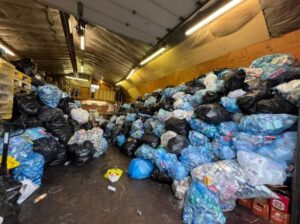
Do you know how much it costs to provide a family of six with a hamper box through the Whitecourt Food Bank? Approximately $185. Do you know how many people utilized the food bank in 2018? Over 1,600 members of the community. Care to wager a guess on if those numbers will go down in 2019? The most likely answer is no. Another important number to recognize is less than 50 per cent because that’s how much less the Whitecourt Food Bank received in monetary donations in 2018 than they did in 2017. Given that the numbers of clients in need is high and unlikely to go down, less than half is frightening.
Though donations cannot be relied upon, some of the monetary donations had been coming in for over a decade. “I know you can’t expect donations but after receiving them for that long you do kind of rely on it. That’s the whole purpose of the food bank is that we rely on the community because we are 100 per cent community-based,” explained Lori Coffey, Director of the food bank.
One big silver lining is that the food bank received the most food they have ever received this past Christmas. “Our shelves were bare in November and I didn’t have money to buy any food. I have never received that many food donations. It was amazing and because of that generosity we are good until about April with food.” The summer months are another hard time for the food bank as most people donate around Christmas. They also received items that they wouldn’t be able to offer otherwise. “We can’t buy personal hygiene products so when we get that donated it’s fantastic because I can’t put money towards that. I must only focus on foods.”
Food donations are an integral part of the food bank as they fill the shelves, but monetary donations are just as important because they keep the doors open. On top of paying rent for the space the food bank utilizes, Coffey uses the funds to purchase perishables. “We get fresh fruits and vegetables every week and include them in every hamper. I think it’s very important. We do have canned fruits and vegetables but it’s just not the same. We also cut out all processed meats because they are very unhealthy and instead provide eggs. We are gearing the food bank towards more healthy options.” She explained that just because people are struggling shouldn’t mean they deserve less nutritious food. “You still need to eat healthy, especially growing children.”
Coffey also has a lunch program for kids. “You can often get lunches at school, but many parents prefer to send their children to school with lunches and I’ve had clients tell me they won’t send their kids to school if they don’t have any food to send with them. It’s expensive to buy those items but it’s an important program.”
With monetary donations at a scary low level, Coffey said she doesn’t know what to do. “If we must cut something, what do we choose? They are all important.” She has been with the food bank for 14 years and has seen it grow from a three-shelf operation to a big scale one. “When I first started, I was dealing with 20 to 40 people a month. My lowest month last year was 107 and my average each month is around 140.”
One of the biggest reasons for a shortfall in money aside from the loss in donations, is the flood that happened January 1, 2018 at the Carlan Community Resource Centre where the food bank is situated. The flood wiped out a large amount of the food due to a lack of shelving and they have yet to receive an insurance payment. “We had to recover from a flood and it was more money than expected.” Once they receive a payment it will certainly help but they aren’t expecting to receive equal to what they lost. Thankfully, there is now a shelving system that keeps everything off the floor.
Coffey stretches her dollars to get the most for each buck. Buying in bulk is a big part of that but it costs money and without community support the funds are simply not there to utilize. Residents might be surprised to learn that the food bank is not government-funded but relies on the community to offer the help they do. “We need to be able to operate. We don’t need anything extra; we just want to keep things running the way they are without decreasing fills or the number of times you can come or any of our programs.”
Clients used to be able to use the food bank three times per year but that has been increased to six. “If you are a family of six to eight people and you come in here six times a year, then that costs $1,110. That’s one family. One person who comes in six times a year costs $330. Last year over 1,600 people used the food bank. Our numbers keep increasing and Alberta isn’t getting any better. We all just saw that huge convoy in town showing just how bad it is and when things get bad, people come here,” said Coffey.
She said that there is a stigma attached to using the food bank and that it needs to change. “When people come in here, they are at their lowest. There is no shame in coming here. Things happen, and we are here to help. If people are sitting at home and trying to choose between paying for their electricity and buying groceries, then I want them to pay their electricity bill and come here for food.”
She added that part of the misconception which grows the stigma is that people who use the food bank are somehow lazy or abusers. “There may be abusers in every system but not here. Generally, it is good, hard-working people that just need a hand. They don’t want to use the food bank, they need to use the food bank.” In fact, over 40 per cent of her clients are actively working but still need help as they get on their feet. The other 60 per cent is made up of children, those injured at work, seniors, and disabled persons living on fixed incomes.
Of the over 1,600 people helped by the food bank last year 600 were children. “That’s significant. We can’t let them down.” Coffey said they are sticklers for fraudulent fillers and that greater focus is being put on stopping those who try to misuse the service. “My job is to protect the money and see through fraud. That’s why I’m here and the community entrusts me to do that.”
Coffey said she is immensely grateful for the donations they receive and says every donation no matter what size is important. For individuals and companies now in the process of budgeting their donations for the year, she simply asks to be considered. “This is a place that makes you feel good. I know there are other places in town to donate to but all I ask is to be kept on your roster of places. I encourage people to come down and see what we do.”
The Whitecourt Food Bank is open Mondays, Wednesdays, and Fridays from 11 a.m. until 2 p.m. “If you’ve never had hardships and you’ve never had to go to a food bank, then you have no idea what that’s like. Some people think we don’t need a food bank, but you don’t need it until you need it and if you do, we will be here for you.”







More Stories
Improving the streets and sidewalks through the 2025 Street Improvement Program
Community spirit shines at large-scale youth baseball event
Birthday party chaos sung beautifully by Pumpjack Players’ youth in spring musical